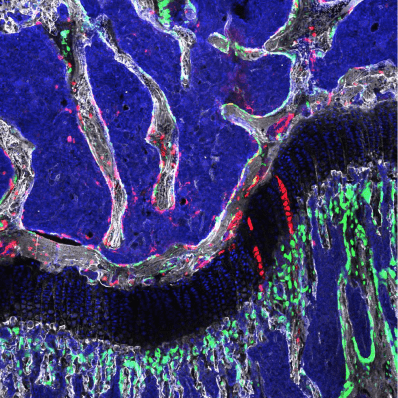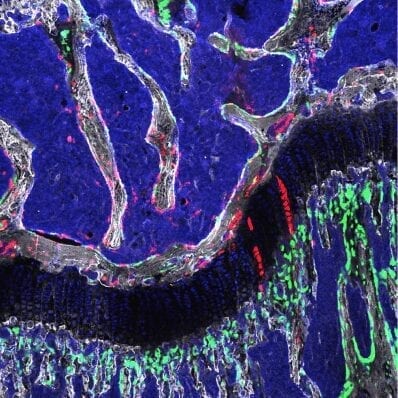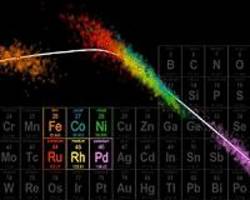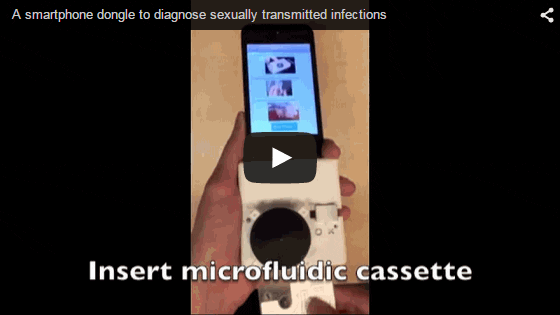
Cells could be exploited to treat osteoarthritis and osteoporosis
A stem cell capable of regenerating both bone and cartilage has been identified in bone marrow of mice. The discovery by researchers at Columbia University Medical Center (CUMC) is reported today in the online issue of the journal Cell.
The cells, called osteochondroreticular (OCR) stem cells, were discovered by tracking a protein expressed by the cells. Using this marker, the researchers found that OCR cells self-renew and generate key bone and cartilage cells, including osteoblasts and chondrocytes. Researchers also showed that OCR stem cells, when transplanted to a fracture site, contribute to bone repair.
“We are now trying to figure out whether we can persuade these cells to specifically regenerate after injury. If you make a fracture in the mouse, these cells will come alive again, generate both bone and cartilage in the mouse—and repair the fracture. The question is, could this happen in humans,” says Siddhartha Mukherjee, MD, PhD, assistant professor of medicine at CUMC and a senior author of the study.
The researchers believe that OCR stem cells will be found in human bone tissue, as mice and humans have similar bone biology. Further study could provide greater understanding of how to prevent and treat osteoporosis, osteoarthritis, or bone fractures.
“Our findings raise the possibility that drugs or other therapies can be developed to stimulate the production of OCR stem cells and improve the body’s ability to repair bone injury—a process that declines significantly in old age,” says Timothy C. Wang, MD, the Dorothy L. and Daniel H. Silberberg Professor of Medicine at CUMC, who initiated this research. Previously, Dr. Wang found an analogous stem cell in the intestinal tract and observed that it was also abundant in the bone.
Read more: Bone stem cells shown to regenerate bone and cartilage in adult mice
The Latest on: Bone stem cells
[google_news title=”” keyword=”Bone stem cells” num_posts=”10″ blurb_length=”0″ show_thumb=”left”]
via Google News
The Latest on: Bone stem cells
- Aplastic anaemia causes your blood cell production to go downon May 1, 2024 at 8:00 pm
In this blood disease, the bone marrow can’t make enough blood cells and platelets for the body to function normally.
- Mesenchymal Stem Cells Market Will Increase USD 10 Billion By 2033on May 1, 2024 at 5:00 pm
According to Market.us, the Mesenchymal Stem Cells Market Size is expected to achieve a value of around USD 10 billion by the year 2033. This indicates a noteworthy escalation from its 2023 valuation ...
- Unlocking the secrets of long-lived hematopoietic stem cellson April 30, 2024 at 10:24 pm
HSCs typically remain dormant within the bone marrow, yet they possess the ability to activate ... and genetically eliminating cyclophilin A accelerated natural aging in the stem cell compartment. In ...
- The Secret of Long-Lived Stem Cells' Ability To Avert Aging Revealedon April 30, 2024 at 5:00 pm
HSCs typically remain dormant within the bone marrow, yet they possess the ability to activate ... and genetically eliminating cyclophilin A accelerated natural aging in the stem cell compartment. In ...
- Study uncovers the secret of long-lived stem cellson April 30, 2024 at 1:20 pm
Nothing lives forever, but compared to other cells in the body, hematopoietic stem cells (HSCs) are remarkably long-lived. HSCs are blood-forming cells—they give rise to rapidly dividing progenitor ...
- New regimen boosts bone marrow transplant as ‘curative’ SCD optionon April 30, 2024 at 7:30 am
A Phase 2 bone marrow transplant trial in SCD patients using haploidentical donors and lower intensity conditioning had high survival rates.
- After Childhood Cancer Diagnosis, Donor Bone Marrow from Little Sister Sends it into Remissionon April 30, 2024 at 6:00 am
Remarkably, it was none other than 6-year-old Ruby Leaning's 2-year-old sister, Mabel, who came up as a perfect matching donor.
- Young man in Yerevan donates stem cells to help save his sister’s lifeon April 29, 2024 at 4:15 pm
Photos courtesy of the Armenian Bone Marrow Donor Registry LOS ANGELES—On April 10, 2024, a young Yerevan resident, Garik Petrosyan, donated bone marrow stem cells for an urgent transplant that might ...
- Irregular bone marrow cells may increase heart disease riskon April 26, 2024 at 4:00 am
Over time, bone marrow stem cells develop key genetic errors and pass them on to immune cells. This may increase the risk of developing heart disease.
- Stem Cell Magic: Scientists Unveil New Superhero for Healing Diabetes Woundson April 23, 2024 at 10:13 am
Researchers unveiled a novel therapy for diabetic wound healing. The new research highlights the use of exosomal miR-4645-5p from hypoxic bone marrow mesenchymal stem cells (BMSCs) to significantly ...
via Bing News











